Broadband Characteristics of Zooplankton Sound Scattering Layer in the Kuroshio–Oyashio Confluence Region of the Northwest Pacific Ocean in Summer of 2019
Abstract
:1. Introduction
2. Materials and Methods
2.1. Survey Information
2.2. Data Collection
2.3. Noise Removal
2.4. Analysis of Volume Backscattering Strength
2.5. Analysis of Echo-Integration
2.6. Analysis of Scattering Diel Variation
3. Results
3.1. Average Volume Backscattering Strength
3.2. Echo-Integration
3.3. Diel Variation of Scattering Strength
4. Discussion
4.1. Broadband Scattering Spectrogram
4.2. Echo-Integration
Author Contributions
Funding
Institutional Review Board Statement
Informed Consent Statement
Data Availability Statement
Acknowledgments
Conflicts of Interest
References
- Howell, E.A.; Bograd, S.J.; Morishige, C.; Seki, M.P.; Polovina, J.J. On North Pacific circulation and associated marine debris concentration. Mar. Pollut. Bull. 2012, 65, 16–22. [Google Scholar] [CrossRef]
- Sugimoto, S.; Hanawa, K. Roles of SST anomalies on the wintertime turbulent heat fluxes in the Kuroshio-Oyashio confluence region: Influences of warm eddies detached from the Kuroshio extension. J. Clim. 2011, 24, 6551–6561. [Google Scholar] [CrossRef]
- Mitsudera, H.; Taguchi, B.; Yoshikawa, Y.; Nakamura, H.; Waseda, T.; Qu, T.D. Numerical study on the Oyashio water pathways in the Kuroshio–Oyashio confluence. J. Phys. Oceanogr. 2004, 34, 1174–1196. [Google Scholar] [CrossRef]
- Sugimoto, S.; Kobayashi, N.; Hanawa, K. Quasi-decadal variation in intensity of the western part of the winter subarctic SST front in the western north Pacific: The influence of Kuroshio extension path state. J. Phys. Oceanogr. 2014, 44, 2753–2762. [Google Scholar] [CrossRef]
- Tian, S.Q.; Xue, M.H.; Tong, J.F.; Wang, X.F. A review of the acoustic target strength of fishery resources in the North Pacific Ocean. J. Fish. Sci. China 2021, 28, 371–379. [Google Scholar]
- Lin, M.; Wang, C.G.; Wang, Y.G.; Xiang, P.; Wang, Y.; Lian, G.S.; Chen, R.X.; Chen, X.Y.; Ye, Y.Y.; Dai, Y.Y.; et al. Zooplanktonic diversity in the Western Pacific. Biodiv. Sci. 2011, 19, 646–654. [Google Scholar]
- Huang, R.H.; Huangfu, J.L.; Wu, L.; Feng, T.; Chen, G.H. Research on the interannual and interdecadal variabilities of the monsoon trough and their impacts on tropical cyclone genesis over the Western North Pacific Ocean. J. Trop. Meteorol. 2018, 24, 395–420. [Google Scholar]
- Freeshah, M.; Zhang, X.H.; Şentürk, E.; Adil, M.A.; Mousa, B.G.; Tariq, A.; Ren, X.D.; Refaat, M. Analysis of atmospheric and ionospheric variations due to impacts of super typhoon Mangkhut (1822) in the Northwest Pacific Ocean. Remote Sens. 2021, 13, 661. [Google Scholar] [CrossRef]
- Miyamoto, H.; Vijai, D.; Kidokoro, H.; Tadokoro, K.; Watanabe, T.; Fuji, T.; Suyama, S. Geographic variation in feeding of Pacific saury Cololabis saira in June and July in the North Pacific Ocean. Fish. Oceanogr. 2020, 29, 558–571. [Google Scholar] [CrossRef]
- Chiba, S.; Sugisaki, H.; Nonaka, M.; Saino, T. Geographical shift of zooplankton communities and decadal dynamics of the Kuroshio-Oyashio currents in the western North Pacific. Global Change Biol. 2009, 15, 1846–1858. [Google Scholar] [CrossRef]
- Sun, D.; Wang, C.H. Latitudinal distribution of zooplankton communities in the Western Pacific along 160° E during summer 2014. J. Marine Syst. 2017, 169, 52–60. [Google Scholar] [CrossRef]
- Sun, D.; Zhang, D.S.; Zhang, R.Y.; Wang, C.S. Different vertical distribution of zooplankton community between North Pacific Subtropical Gyre and Western Pacific Warm Pool: Its implication to carbon flux. Acta Oceanol. Sin. 2019, 38, 32–45. [Google Scholar] [CrossRef]
- Sigler, M.F.; Csepp, D.J. Seasonal abundance of two important forage species in the North Pacific Ocean, Pacific herring and walleye pollock. Fish. Res. 2007, 83, 319–331. [Google Scholar] [CrossRef]
- Hewitt, R.P.; Demer, D.A. The use of acoustic sampling to estimate the dispersion and abundance of euphausiids, with an emphasis on Antarctic krill, Euphausia superba. Fish. Res. 2000, 47, 215–229. [Google Scholar] [CrossRef]
- Cooney, R.T. Acoustic evidence for the vertical partitioning of biomass in the epipelagic zone of the Gulf of Alaska. Deep-Sea Res. Part A 1989, 36, 1177–1189. [Google Scholar] [CrossRef]
- Nash, R.D.M.; Magnuson, J.J.; Stanton, T.K.; Clay, C.S. Distribution of peaks of 70 kHz acoustic scattering in relation to depth and temperature during day and night at the edge of the Gulf Stream-Echo Front 83. Deep-Sea Res. Part A 1989, 36, 587–596. [Google Scholar] [CrossRef]
- Nero, R.W.; Magnuson, J.J.; Brandt, S.B.; Stanton, T.K.; Jech, J.M. Finescale biological patchiness of 70kHz acoustic scattering at the edge of the Gulf Stream-Echo Front 85. Deep-Sea Res. Part A 1990, 37, 999–1016. [Google Scholar] [CrossRef]
- Chiba, S.; Lorenzo, E.D.; Davis, A.; Keister, J.E.; Taguchi, B.; Sasai, Y.; Sugisaki, H. Large-scale climate control of zooplankton transport and biogeography in the Kuroshio-Oyashio Extension region. Geophys. Res. Lett. 2013, 40, 5182–5187. [Google Scholar] [CrossRef]
- Roberts, P.L.D.; Jaffe, J.S. Classification of live, untethered zooplankton from observations of multiple-angle acoustic scatter. J. Acoust. Soc. Am. 2008, 124, 796–802. [Google Scholar] [CrossRef]
- Ross, T.; Keister, J.E.; Lara-Lopez, A. On the use of high-frequency broadband sonar to classify biological scattering layers from a cabled observatory in Saanich Inlet, British Columbia. Methods Oceanogr. 2013, 5, 19–38. [Google Scholar] [CrossRef]
- Blanluet, A.; Doray, M.; Berger, L.; Romagnan, J.B.; Bouffant, N.L.; Lehuta, L.; Petitgas, P. Characterization of sound scattering layers in the Bay of Biscay using broadband acoustics, nets and video. PLoS ONE 2019, 14, e0223618. [Google Scholar] [CrossRef] [PubMed]
- Proud, R.; Cox, M.J.; Wotherspoon, S.; Brierley, A.S. A method for identifying sound scattering layers and extracting key characteristics. Meth. Ecol. Evol. 2015, 6, 1190–1198. [Google Scholar] [CrossRef] [Green Version]
- Irigoien, X.; Klevjer, T.A.; Røstad, A.; Martinez, U.; Boyra, G.; Acuña, J.L.; Bode, A.; Echevarria, F.; Gonzalez-Gordillo, J.I.; Hernandez-Leon, S.; et al. Large mesopelagic fishes biomass and trophic efficiency in the open ocean. Nat. Commun. 2014, 5, 3271. [Google Scholar] [CrossRef] [PubMed] [Green Version]
- Proud, R.; Cox, M.J.; Le Guen, C.; Brierley, A.S. Fine-scale depth structure of pelagic communities throughout the global ocean based on acoustic sound scattering layers. Mar. Ecol. Prog. Ser. 2018, 598, 35–48. [Google Scholar] [CrossRef] [Green Version]
- Demer, D.A.; Berger, L.; Bernasconi, M.; Bethke, E.; Boswell, K.; Chu, D.; Domokos, R.; Dunford, A.; Fassler, S.; Gauthier, S. Calibration of Acoustic Instruments, 1st ed.; International Council for the Exploration of the Sea: Copenhagen, Denmark, 2015; pp. 34–39. [Google Scholar]
- Earth: A Global Map of Wind, Weather, and Ocean Conditions. Available online: https://earth.nullschool.net/ (accessed on 7 May 2021).
- Ladroit, Y.; Escobar-Flores, P.C.; Schimel, A.C.G.; O’Driscoll, R.L. ESP3: An open-source software for the quantitative processing of hydro-acoustic data. SoftwareX 2020, 12, 100581. [Google Scholar] [CrossRef]
- Robertis, A.D.; Higginbottom, I. A post-processing technique to estimate the signal-to-noise ratio and remove echosounder background noise. ICES J. Mar. Sci. 2007, 64, 1282–1291. [Google Scholar] [CrossRef] [Green Version]
- Ryan, T.E.; Downie, R.A.; Kloser, R.J.; Keith, G. Reducing bias due to noise and attenuation in open-ocean echo integration data. ICES J. Mar. Sci. 2015, 72, 2482–2493. [Google Scholar] [CrossRef] [Green Version]
- Anderson, C.I.H.; Brierley, A.S.; Armstrong, F. Spatio-temporal variability in the distribution of epi- and meso-pelagic acoustic backscatter in the Irminger Sea, North Atlantic, with implications for predation on Calanus finmarchicus. Mar. Biol. 2004, 146, 1177–1188. [Google Scholar] [CrossRef]
- Iida, K.; Mukai, T.; Hwang, D. Relationship between acoustic backscattering strength and density of zooplankton in the sound-scattering layer. ICES J. Mar. Sci. 1996, 53, 507–512. [Google Scholar] [CrossRef]
- Simmonds, J.; MacLennan, D.N. Fisheries Acoustics: Theory and Practice, 2nd ed.; Blackwell Publishing: Hoboken, NJ, USA, 2005. [Google Scholar]
- Lavery, A.C.; Wiebe, P.H.; Stanton, T.K.; Lawson, G.L.; Benfield, M.C.; Copley, N. Determining dominant scatterers of sound in mixed zooplankton populations. J. Acoust. Soc. Am. 2007, 122, 3304–3326. [Google Scholar] [CrossRef] [Green Version]
- Urick, R.J. Principles of Underwater Sound, 3rd ed.; Peninsula Publishing: Westport, CT, USA, 2013. [Google Scholar]
- Batzler, W.E.; Vent, R.J. Volume-scattering measurements at 12 kc/sec in the Western Pacific. J. Acoust. Soc. Am. 1967, 41, 154–157. [Google Scholar] [CrossRef]
- Lyu, L.G.; Qiao, F.L.; Ge, R.F.; Lu, Y.; Liu, J.J. Study on the relationship between backscatter strength and thermocline. Adv. Mar. Sci. 2003, 21, 465–470. [Google Scholar]
- Kaartvedt, S.; Røstad, A.; Aksnes, D.L. Changing weather causes behavioral responses in the lower mesopelagic. Mar. Ecol. Prog. Ser. 2017, 574, 259–263. [Google Scholar] [CrossRef]
- Klevjer, T.A.; Irigoien, X.; Røstad, A.; Fraile-Nuez, E.; Benítez-Barrios, V.M.; Kaartvedt, S. Large scale patterns in vertical distribution and behaviour of mesopelagic scattering layers. Sci. Rep. 2016, 6, 19873. [Google Scholar] [CrossRef] [PubMed] [Green Version]
- Aksnes, D.L.; Røstad, A.; Kaartvedt, S.; Martinez, U.; Duarte, C.M.; Irigoien, X. Light penetration structures the deep acoustic scattering layers in the global ocean. Sci. Adv. 2017, 3, e1602468. [Google Scholar] [CrossRef] [PubMed] [Green Version]
- Aoki, I.; Inagaki, T. Acoustic observations of fish schools and scattering layers in a Kuroshio warm-core ring and its environs. Fish. Oceanogr. 1992, 1, 137–142. [Google Scholar] [CrossRef]
- Teo, S.L.H.; Kudela, R.M.; Rais, A.; Perle, C.; Costa, D.P.; Block, B.A. Estimating chlorophyll profiles from electronic tags deployed on pelagic animals. Aquat. Biol. 2009, 5, 195–207. [Google Scholar] [CrossRef]
- Proud, R.; Cox, M.J.; Brierley, A.S. Biogeography of the global ocean’s mesopelagic zone. Curr. Biol. 2017, 27, 113–119. [Google Scholar] [CrossRef] [Green Version]
- Omand, M.M.; Steinberg, D.K.; Stamieszkin, K. Cloud shadows drive vertical migrations of deep-dwelling marine life. Proc. Natl. Acad. Sci. USA 2021, 118, e2022977118. [Google Scholar] [CrossRef]
- Last, K.S.; Hobbs, L.; Berge, J.; Brierley, A.S.; Cottier, F. Moonlight drives ocean-scale mass vertical migration of zooplankton during the Arctic winter. Curr. Biol. 2016, 26, 244–251. [Google Scholar] [CrossRef] [Green Version]
- Petrusevich, V.Y.; Dmitrenko, I.A.; Niemi, A.; Kirillov, S.A.; Kamula, C.M.; Kuzyk, Z.Z.A.; Barber, D.G.; Ehn, J.K. Impact of tidal dynamics on diel vertical migration of zooplankton in Hudson Bay. Ocean Sci. 2020, 16, 337–353. [Google Scholar] [CrossRef] [Green Version]
- Stanton, T.K.; Chu, D.; Jech, J.M.; Irish, J.D. New broadband methods for resonance classification and high-resolution imagery of fish with swimbladders using a modified commercial broadband echosounder. ICES J. Mar. Sci. 2010, 67, 365–378. [Google Scholar] [CrossRef] [Green Version]
- Holliday, D.V. Extracting bio-physical information from the acoustic signatures of marine organisms. In: Oceanic sound scattering prediction. Ocean. Sound Scatt. Predict. 1977, 5, 619–624. [Google Scholar]
- Greenlaw, C.F. Acoustical estimation of zooplankton populations. Limnol. Oceanogr. 1979, 24, 226–242. [Google Scholar] [CrossRef]
- Lawson, G.L.; Wiebe, P.H.; Stanton, T.K.; Ashjian, C.J. Euphausiid distribution along the Western Antarctic Peninsula-Part A: Development of robust multi-frequency acoustic techniques to identify euphausiid aggregations and quantify euphausiid size, abundance, and biomass. Deep-Sea Res. Part II 2008, 55, 412–431. [Google Scholar] [CrossRef]
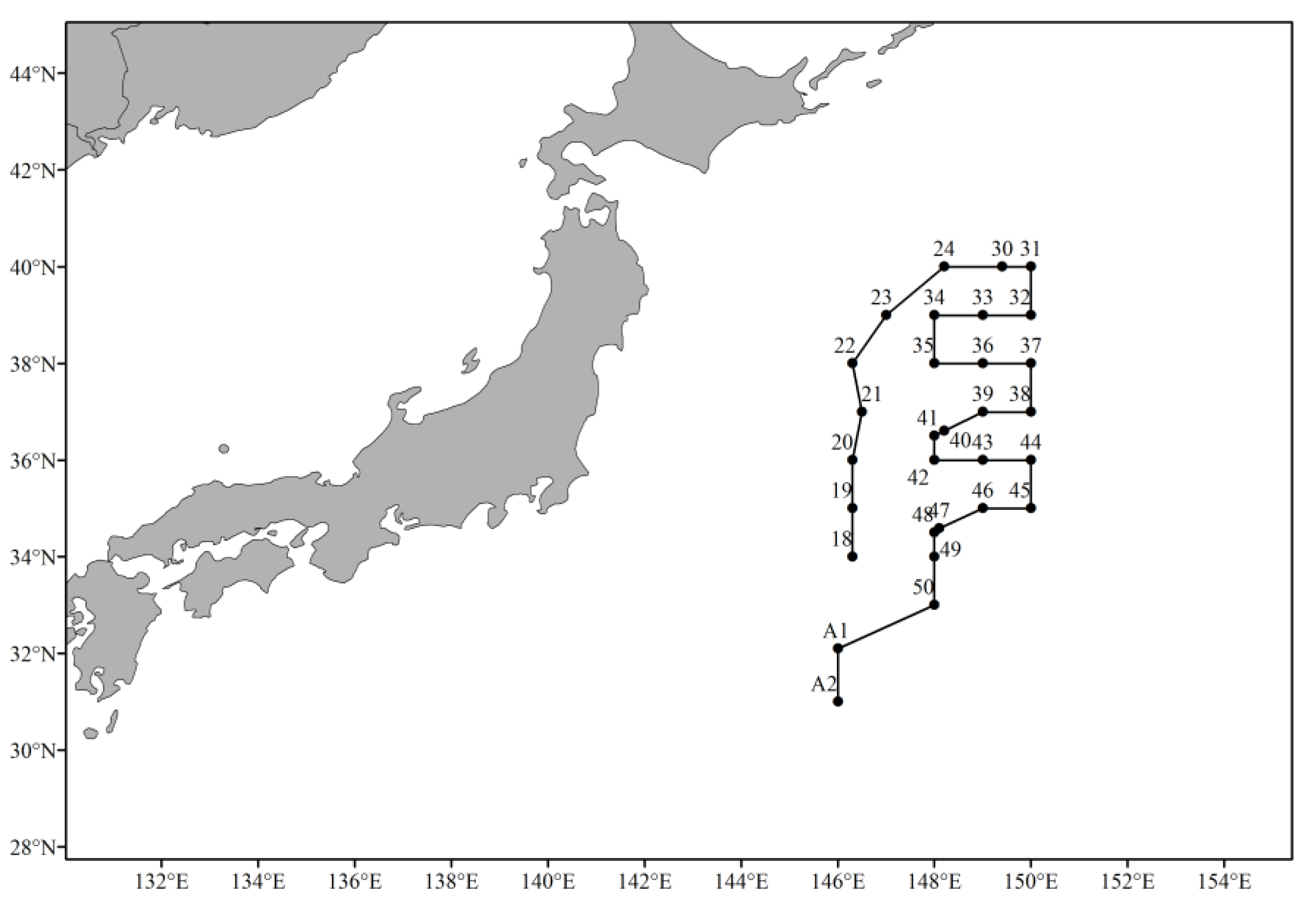
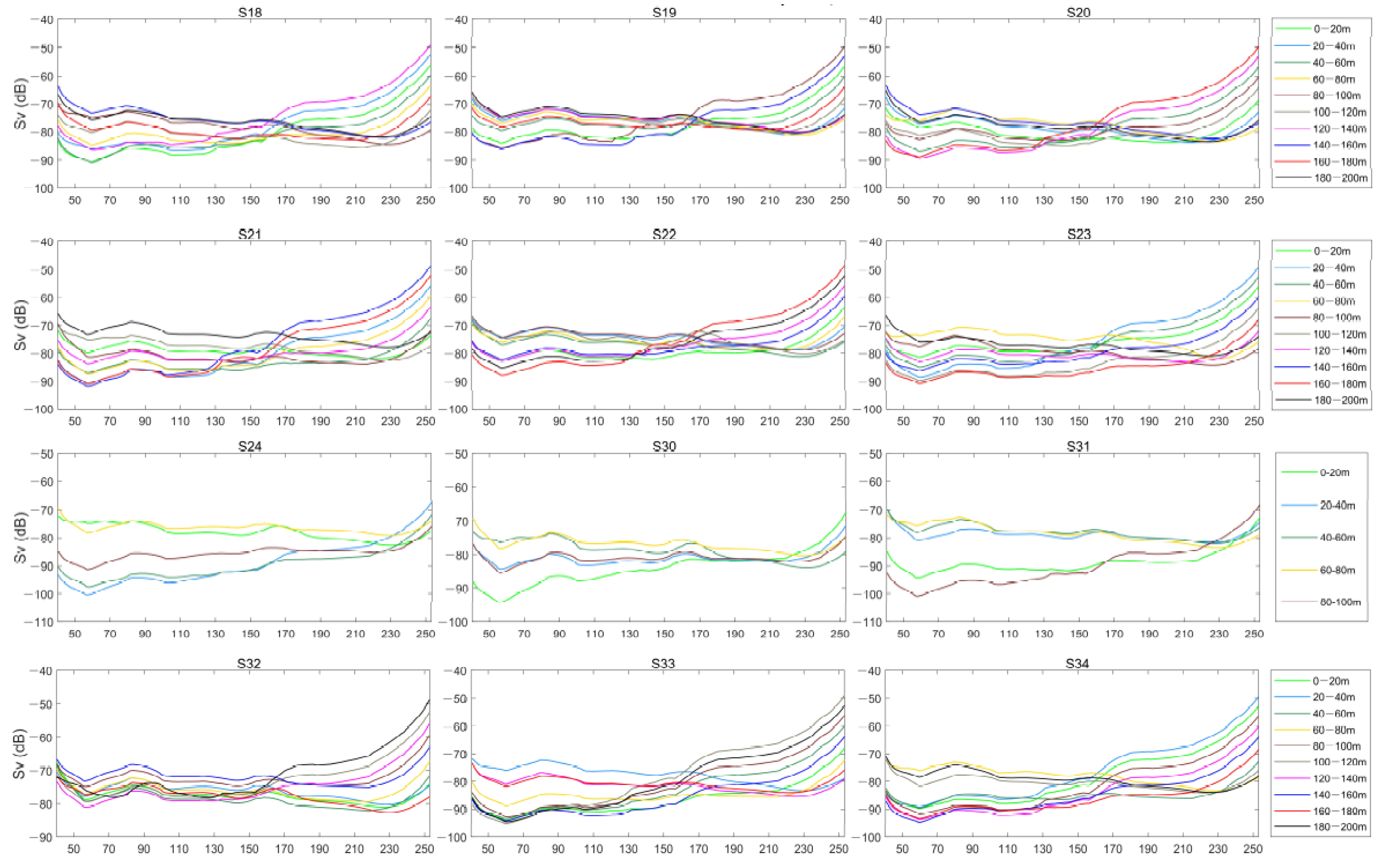
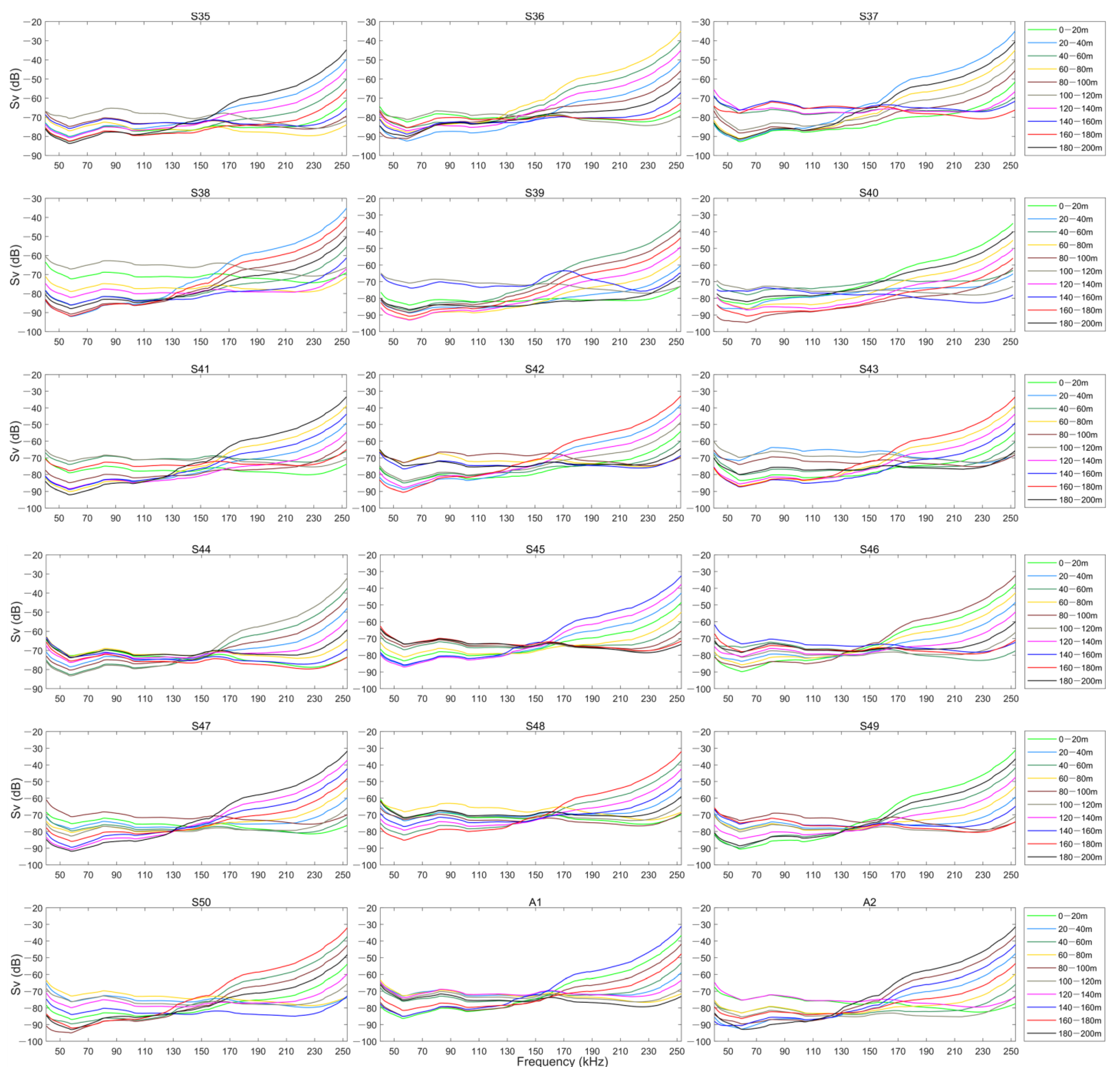
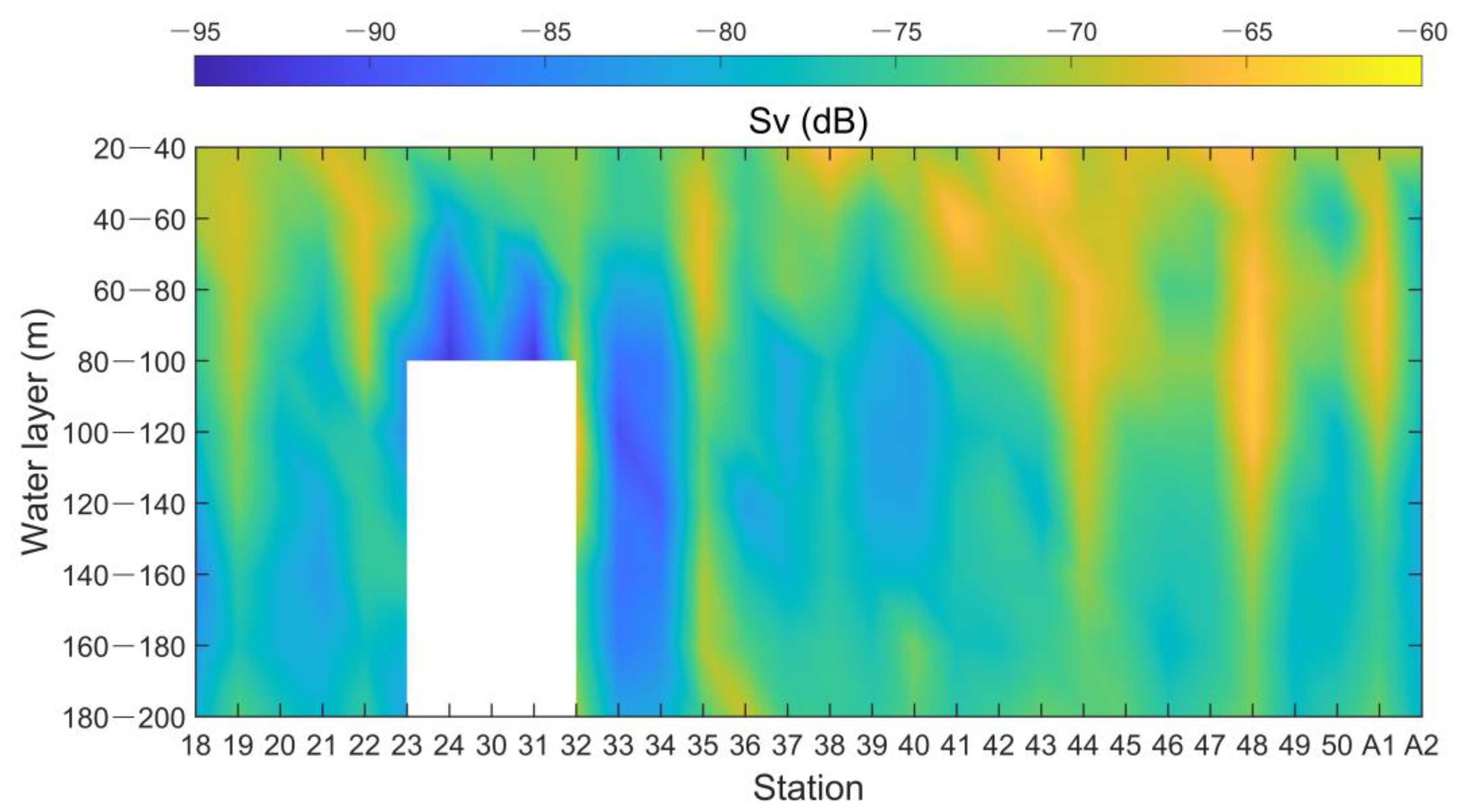

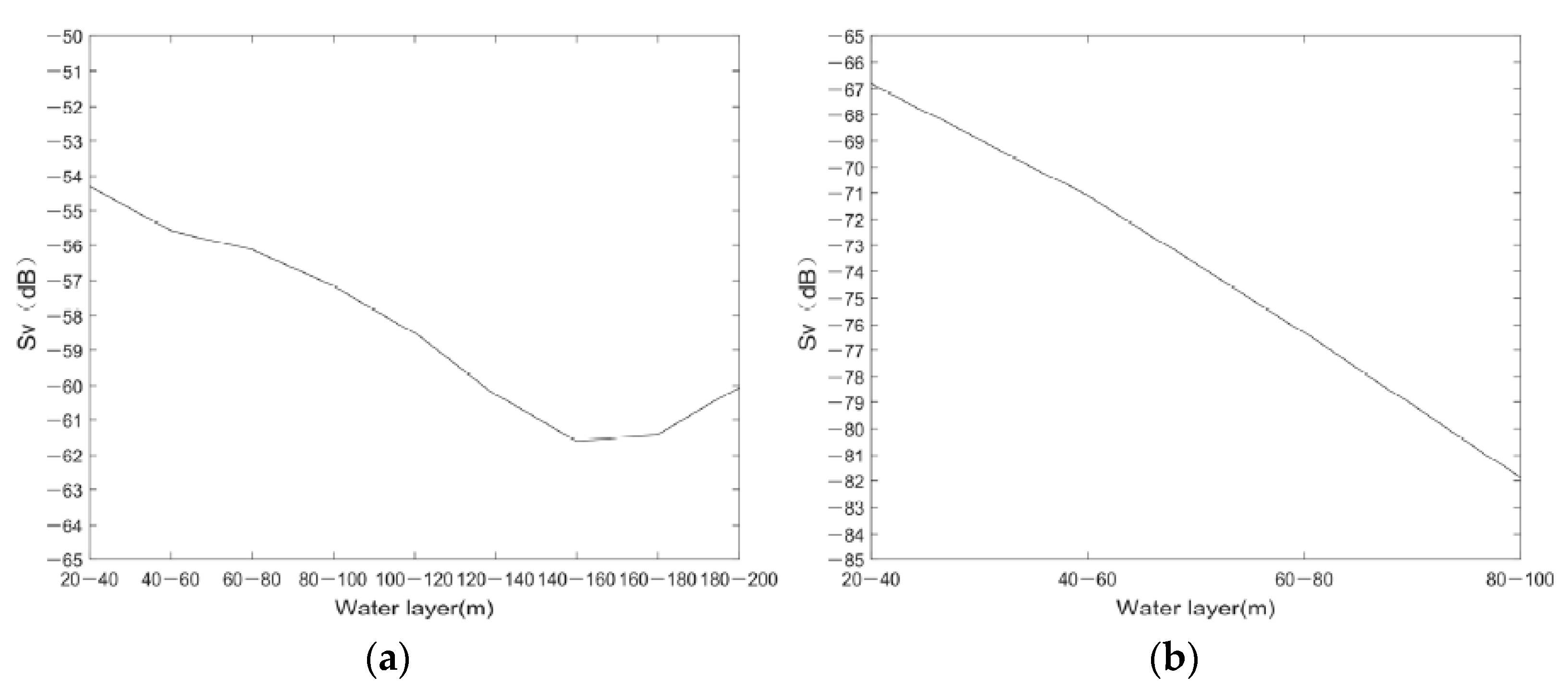

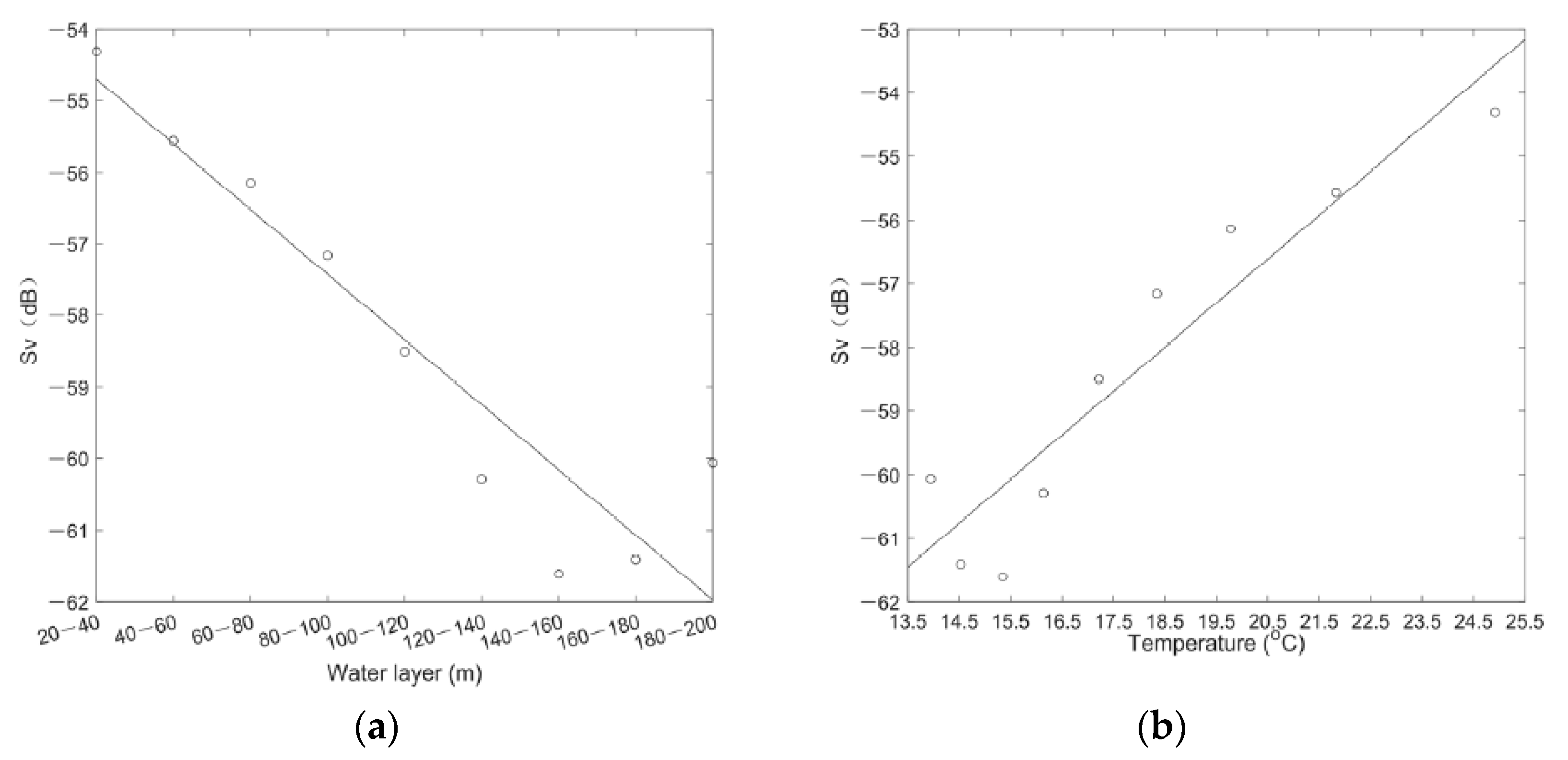
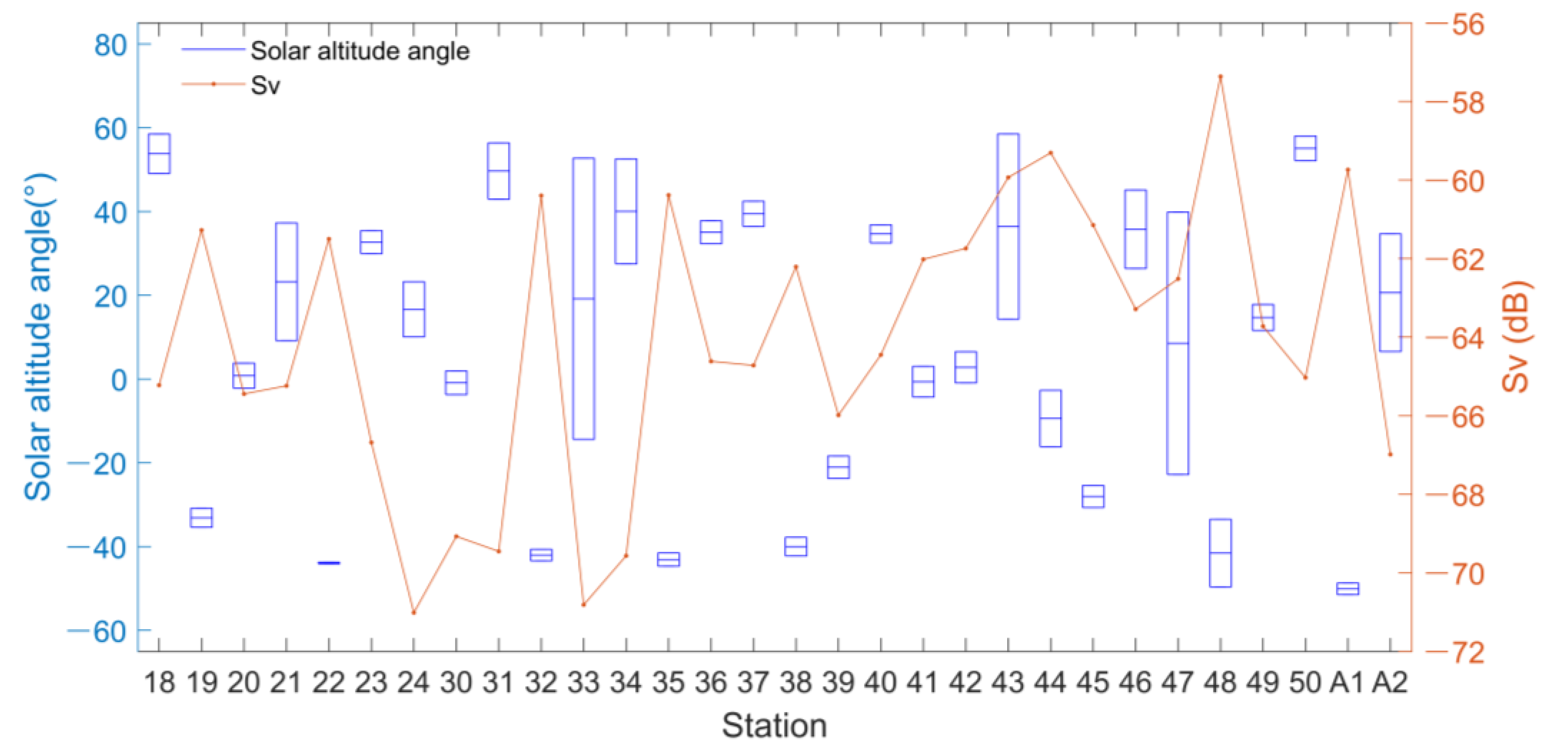
| Technical Parameters | Parameter Settings | |||
|---|---|---|---|---|
| 38 kHz | 70 kHz | 120 kHz | 200 kHz | |
| Transducer type | ES38-7 | ES70-7C | ES120-7C | ES200-7C |
| Broadband range (kHz) | 34–45 | 45–90 | 90–170 | 160–260 |
| Transmit power (W) | 2000 | 750 | 250 | 150 |
| Pulse duration (ms) | 4.096 | 4.096 | 4.096 | 4.096 |
| Ping interval (ms) | 1999 | 1999 | 1999 | 1999 |
| Beam angle | 7° | 7° | 7° | 7° |
Publisher’s Note: MDPI stays neutral with regard to jurisdictional claims in published maps and institutional affiliations. |
© 2021 by the authors. Licensee MDPI, Basel, Switzerland. This article is an open access article distributed under the terms and conditions of the Creative Commons Attribution (CC BY) license (https://creativecommons.org/licenses/by/4.0/).
Share and Cite
Xue, M.; Tong, J.; Tian, S.; Wang, X. Broadband Characteristics of Zooplankton Sound Scattering Layer in the Kuroshio–Oyashio Confluence Region of the Northwest Pacific Ocean in Summer of 2019. J. Mar. Sci. Eng. 2021, 9, 938. https://doi.org/10.3390/jmse9090938
Xue M, Tong J, Tian S, Wang X. Broadband Characteristics of Zooplankton Sound Scattering Layer in the Kuroshio–Oyashio Confluence Region of the Northwest Pacific Ocean in Summer of 2019. Journal of Marine Science and Engineering. 2021; 9(9):938. https://doi.org/10.3390/jmse9090938
Chicago/Turabian StyleXue, Minghua, Jianfeng Tong, Siquan Tian, and Xuefang Wang. 2021. "Broadband Characteristics of Zooplankton Sound Scattering Layer in the Kuroshio–Oyashio Confluence Region of the Northwest Pacific Ocean in Summer of 2019" Journal of Marine Science and Engineering 9, no. 9: 938. https://doi.org/10.3390/jmse9090938
APA StyleXue, M., Tong, J., Tian, S., & Wang, X. (2021). Broadband Characteristics of Zooplankton Sound Scattering Layer in the Kuroshio–Oyashio Confluence Region of the Northwest Pacific Ocean in Summer of 2019. Journal of Marine Science and Engineering, 9(9), 938. https://doi.org/10.3390/jmse9090938







